Christoph von Tycowicz
Bi-invariant Geodesic Regression with Data from the Osteoarthritis Initiative
Feb 17, 2025

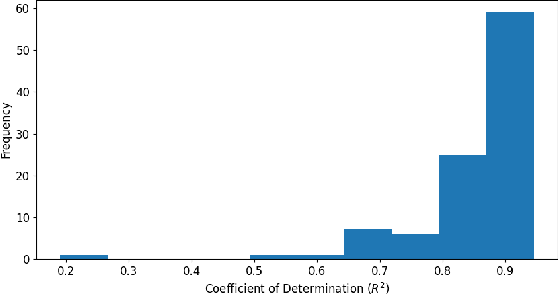

Abstract:Many phenomena are naturally characterized by measuring continuous transformations such as shape changes in medicine or articulated systems in robotics. Modeling the variability in such datasets requires performing statistics on Lie groups, that is, manifolds carrying an additional group structure. As the Lie group captures the symmetries in the data, it is essential from a theoretical and practical perspective to ask for statistical methods that respect these symmetries; this way they are insensitive to confounding effects, e.g., due to the choice of reference coordinate systems. In this work, we investigate geodesic regression -- a generalization of linear regression originally derived for Riemannian manifolds. While Lie groups can be endowed with Riemannian metrics, these are generally incompatible with the group structure. We develop a non-metric estimator using an affine connection setting. It captures geodesic relationships respecting the symmetries given by left and right translations. For its computation, we propose an efficient fixed point algorithm requiring simple differential expressions that can be calculated through automatic differentiation. We perform experiments on a synthetic example and evaluate our method on an open-access, clinical dataset studying knee joint configurations under the progression of osteoarthritis.
Manifold GCN: Diffusion-based Convolutional Neural Network for Manifold-valued Graphs
Jan 25, 2024



Abstract:We propose two graph neural network layers for graphs with features in a Riemannian manifold. First, based on a manifold-valued graph diffusion equation, we construct a diffusion layer that can be applied to an arbitrary number of nodes and graph connectivity patterns. Second, we model a tangent multilayer perceptron by transferring ideas from the vector neuron framework to our general setting. Both layers are equivariant with respect to node permutations and isometries of the feature manifold. These properties have been shown to lead to a beneficial inductive bias in many deep learning tasks. Numerical examples on synthetic data as well as on triangle meshes of the right hippocampus to classify Alzheimer's disease demonstrate the very good performance of our layers.
Intrinsic shape analysis in archaeology: A case study on ancient sundials
May 30, 2023



Abstract:This paper explores a novel mathematical approach to extract archaeological insights from ensembles of similar artifact shapes. We show that by considering all the shape information in a find collection, it is possible to identify shape patterns that would be difficult to discern by considering the artifacts individually or by classifying shapes into predefined archaeological types and analyzing the associated distinguishing characteristics. Recently, series of high-resolution digital representations of artifacts have become available, and we explore their potential on a set of 3D models of ancient Greek and Roman sundials, with the aim of providing alternatives to the traditional archaeological method of ``trend extraction by ordination'' (typology). In the proposed approach, each 3D shape is represented as a point in a shape space -- a high-dimensional, curved, non-Euclidean space. By performing regression in shape space, we find that for Roman sundials, the bend of the sundials' shadow-receiving surface changes with the location's latitude. This suggests that, apart from the inscribed hour lines, also a sundial's shape was adjusted to the place of installation. As an example of more advanced inference, we use the identified trend to infer the latitude at which a sundial, whose installation location is unknown, was placed. We also derive a novel method for differentiated morphological trend assertion, building upon and extending the theory of geometric statistics and shape analysis. Specifically, we present a regression-based method for statistical normalization of shapes that serves as a means of disentangling parameter-dependent effects (trends) and unexplained variability.
Sasaki Metric for Spline Models of Manifold-Valued Trajectories
Mar 30, 2023



Abstract:We propose a generic spatiotemporal framework to analyze manifold-valued measurements, which allows for employing an intrinsic and computationally efficient Riemannian hierarchical model. Particularly, utilizing regression, we represent discrete trajectories in a Riemannian manifold by composite B\' ezier splines, propose a natural metric induced by the Sasaki metric to compare the trajectories, and estimate average trajectories as group-wise trends. We evaluate our framework in comparison to state-of-the-art methods within qualitative and quantitative experiments on hurricane tracks. Notably, our results demonstrate the superiority of spline-based approaches for an intensity classification of the tracks.
Predicting Shape Development: a Riemannian Method
Dec 09, 2022Abstract:Predicting the future development of an anatomical shape from a single baseline is an important but difficult problem to solve. Research has shown that it should be tackled in curved shape spaces, as (e.g., disease-related) shape changes frequently expose nonlinear characteristics. We thus propose a novel prediction method that encodes the whole shape in a Riemannian shape space. It then learns a simple prediction technique that is founded on statistical hierarchical modelling of longitudinal training data. It is fully automatic, which makes it stand out in contrast to parameter-rich state-of-the-art methods. When applied to predict the future development of the shape of right hippocampi under Alzheimer's disease, it outperforms deep learning supported variants and achieves results on par with state-of-the-art.
A Kendall Shape Space Approach to 3D Shape Estimation from 2D Landmarks
Jul 26, 2022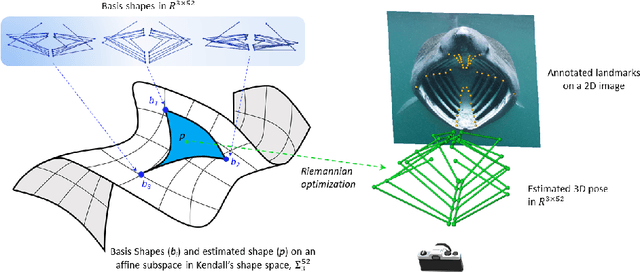
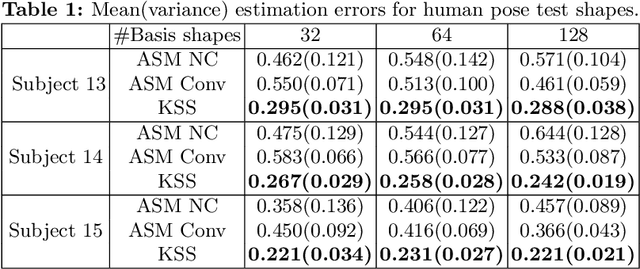


Abstract:3D shapes provide substantially more information than 2D images. However, the acquisition of 3D shapes is sometimes very difficult or even impossible in comparison with acquiring 2D images, making it necessary to derive the 3D shape from 2D images. Although this is, in general, a mathematically ill-posed problem, it might be solved by constraining the problem formulation using prior information. Here, we present a new approach based on Kendall's shape space to reconstruct 3D shapes from single monocular 2D images. The work is motivated by an application to study the feeding behavior of the basking shark, an endangered species whose massive size and mobility render 3D shape data nearly impossible to obtain, hampering understanding of their feeding behaviors and ecology. 2D images of these animals in feeding position, however, are readily available. We compare our approach with state-of-the-art shape-based approaches, both on human stick models and on shark head skeletons. Using a small set of training shapes, we show that the Kendall shape space approach is substantially more robust than previous methods and results in plausible shapes. This is essential for the motivating application in which specimens are rare and therefore only few training shapes are available.
Rigid Motion Invariant Statistical Shape Modeling based on Discrete Fundamental Forms
Nov 05, 2021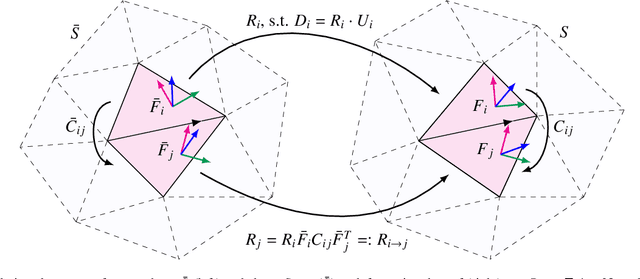


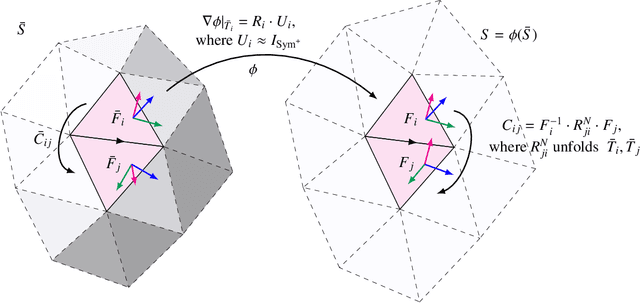
Abstract:We present a novel approach for nonlinear statistical shape modeling that is invariant under Euclidean motion and thus alignment-free. By analyzing metric distortion and curvature of shapes as elements of Lie groups in a consistent Riemannian setting, we construct a framework that reliably handles large deformations. Due to the explicit character of Lie group operations, our non-Euclidean method is very efficient allowing for fast and numerically robust processing. This facilitates Riemannian analysis of large shape populations accessible through longitudinal and multi-site imaging studies providing increased statistical power. Additionally, as planar configurations form a submanifold in shape space, our representation allows for effective estimation of quasi-isometric surfaces flattenings. We evaluate the performance of our model w.r.t. shape-based classification of hippocampus and femur malformations due to Alzheimer's disease and osteoarthritis, respectively. In particular, we outperform state-of-the-art classifiers based on geometric deep learning as well as statistical shape modeling especially in presence of sparse training data. We evaluate the performance of our model w.r.t. shape-based classification of pathological malformations of the human knee and show that it outperforms the standard Euclidean as well as a recent nonlinear approach especially in presence of sparse training data. To provide insight into the model's ability of capturing biological shape variability, we carry out an analysis of specificity and generalization ability.
Geodesic B-Score for Improved Assessment of Knee Osteoarthritis
Mar 12, 2021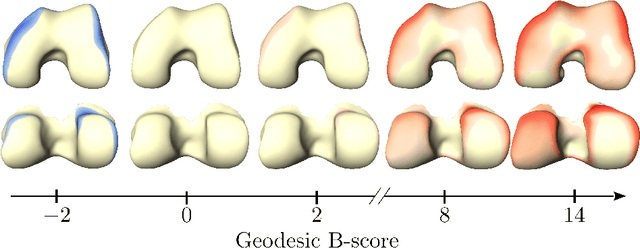
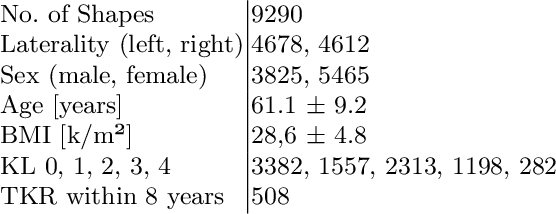
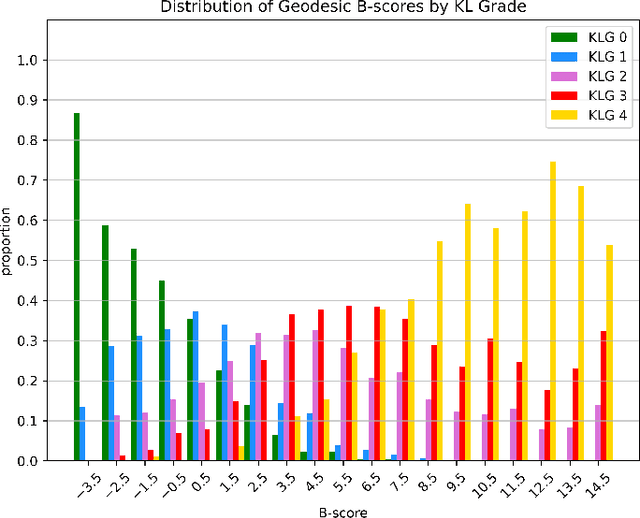
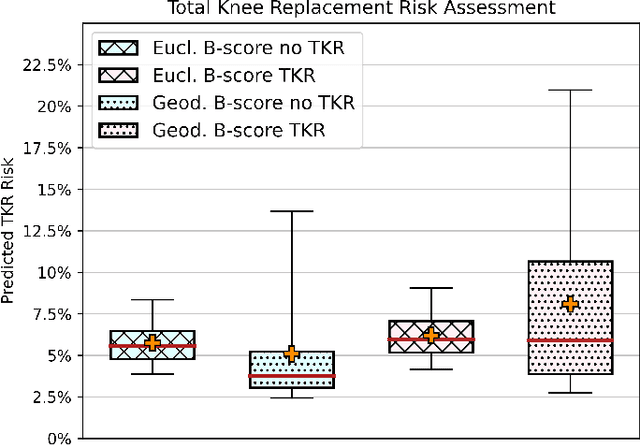
Abstract:Three-dimensional medical imaging enables detailed understanding of osteoarthritis structural status. However, there remains a vast need for automatic, thus, reader-independent measures that provide reliable assessment of subject-specific clinical outcomes. To this end, we derive a consistent generalization of the recently proposed B-score to Riemannian shape spaces. We further present an algorithmic treatment yielding simple, yet efficient computations allowing for analysis of large shape populations with several thousand samples. Our intrinsic formulation exhibits improved discrimination ability over its Euclidean counterpart, which we demonstrate for predictive validity on assessing risks of total knee replacement. This result highlights the potential of the geodesic B-score to enable improved personalized assessment and stratification for interventions.
 Add to Chrome
Add to Chrome Add to Firefox
Add to Firefox Add to Edge
Add to Edge